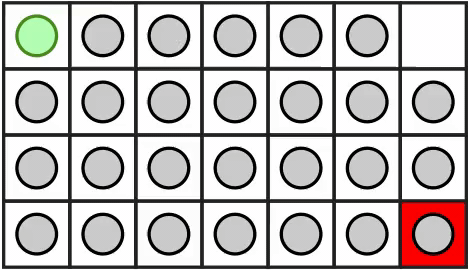题目大意
一个 $n\times m$ 的棋盘上填充着棋子,其中有一个空格。除了一些固定的棋子,空格相邻的棋子可以移动到空格上。一个棋盘上固定的棋子是确定的,给出 $q$ 个询问,对于每个询问回答,空格一开始在 $(ex,ey)$ 时, $(sx,sy)$ 上的指定棋子能否移动到 $(tx,ty)$ 和最少操作数。
$n,m\le30,q\le500$ .
思路
优先考虑初始位置就是目的地的特殊情况,操作数为零。再考虑通常情况,不难从“其实是空格在移动”的方向思考。
指定棋子到目的地的操作示例如图:

不难发现,路径其实分为两段:
- 空格移动到与指定棋子相邻处。若没有空格相邻,棋子肯定动不了,所以第一阶段必然是空格靠近指定棋子;
- 指定棋子与空格一起移动到目的地。由图,它们移动的方式是类似转着圈移动。
对于第一段,由于空格和指定棋子都不确定,每次询问时 BFS 即可。
对于第二段,它们运动的轨迹较为复杂,加之以固定棋子为障碍,或许不好直接“呆板的暴力”。注意到,两者的“一大步”是指定棋子替代空格的位置后,空格再找到合适的相邻处,这“一大步”的操作对于棋盘来说是确定的(可以预处理)。
以此为基础,我们以这“一大步”作为边,两者的位置一并看作点,“一大步”所需操作数为边权建立图论模型。这样,最短路即为第二段的答案。
复杂度 $\mathcal{O}(n^2m^2+qnm\log nm)$ 。
代码
#include <bits/stdc++.h>
#define ll long long
using namespace std;
const int N = 40, mod = 998244353, inf = 1010580540;
inline ll read() {
ll x = 0, f = 1;
char c = getchar();
while (c != '-' && (c < '0' || c > '9')) c = getchar();
if (c == '-') f = -f, c = getchar();
while (c >= '0' && c <= '9') x = (x << 3) + (x << 1) + c - '0', c = getchar();
return x * f;
}
inline int add (int a, int b) { return a + b > mod? a + b - mod: a + b; }
inline int dec (int a, int b) { return a < b? a - b + mod: a - b; }
inline int mul (int a, int b) { return 1ll * a * b % mod; }
namespace Main {
int n, m;
bool a[N][N];
int rots[2][4] = {{0, 1, -1, 0}, {1, 0, 0, -1}};
bool border(int x, int y) { return 1 <= x && x <= n && 1 <= y && y <= m; }
bool able(int x, int y) { return border(x, y) && a[x][y]; }
int head[N * N * 4], etot;
struct edge { int to, nxt, w; } e[N * N * 32];
void add(int u, int v, int w) { e[++etot] = (edge){v, head[u], w}, head[u] = etot; }
struct node { int x, y, rot; };
int id[N][N][4];
int dis[N][N];
bool vis[N][N];
void bfs(int ix, int iy) {
queue<node> q;
q.push({ix, iy, -1});
memset(vis, 0, sizeof vis);
vis[ix][iy] = 1;
while (!q.empty()) {
node u = q.front(); q.pop();
for (int rot = 0; rot < 4; ++rot) {
int x = u.x + rots[0][rot], y = u.y + rots[1][rot];
if (able(x, y) && dis[x][y] > dis[u.x][u.y] + 1) {
dis[x][y] = dis[u.x][u.y] + 1;
if (vis[x][y]) continue; vis[x][y] = 1;
q.push({x, y, -1});
}
}
vis[u.x][u.y] = 0;
}
}
void prework() {
for (int i = 1; i <= n; ++i)
for (int j = 1; j <= m; ++j)
if (able(i, j))
for (int rot = 0; rot < 4; ++rot) {
int x = i + rots[0][rot], y = j + rots[1][rot];
if (able(x, y)) {
int u = (id[i][j][rot]? id[i][j][rot]: (id[i][j][rot] = ++etot));
a[x][y] = 0;
memset(dis, 60, sizeof dis);
dis[i][j] = 1;
// printf ("DEBUG P=(%d,%d)\n", i,j);
bfs(i, j);
for (int rot2 = 0; rot2 < 4; ++rot2) {
int nx = x + rots[0][rot2], ny = y + rots[1][rot2];
if (border(nx, ny) && dis[nx][ny] <= inf) {
int v = (id[x][y][rot2]? id[x][y][rot2]: (id[x][y][rot2] = ++etot));
add(u, v, dis[nx][ny]);
}
}
a[x][y] = 1;
}
}
}
bool vs[N * N * 4];
int dt[N * N * 4];
void spfa(int x, int y) {
queue<int>q;
memset(vs, 0, sizeof vs);
memset(dt, 60, sizeof(int) * (etot + 5));
for (int rot = 0, u; rot < 4; ++rot)
if (u = id[x][y][rot]) {
q.push(u);
dt[u] = dis[x + rots[0][rot]][y + rots[1][rot]];
vs[u] = 1;
}
while(!q.empty()) {
int u = q.front(); q.pop();
for (int i = head[u]; i; i = e[i].nxt) {
int v = e[i].to;
if (!(dt[v] > dt[u] + e[i].w)) continue;
dt[v] = dt[u] + e[i].w;
q.push(v);
}
vs[u] = 0;
}
}
int main () {
n = read(), m = read(); int T = read();
for (int i = 1; i <= n; ++i)
for (int j = 1; j <= m; ++j) a[i][j] = read();
// puts("DEBUG #1");
prework();
// puts("DEBUG #2");
for (; T--; ) {
int ex = read(), ey = read(), sx = read(), sy = read(), tx = read(), ty = read();
if (sx == tx && sy == ty) { puts("0"); continue;}
a[sx][sy] = 0;
memset (dis, 60, sizeof dis);
dis[ex][ey] = 0;
bfs(ex, ey);
a[sx][sy] = 1;
spfa(sx, sy);
int ans = inf;
for (int rot = 0; rot < 4; ++rot) ans = min(ans, dt[id[tx][ty][rot]]);
printf ("%d\n", (ans == inf? -1: ans));
}
return 0;
}
}
int main () {
string str = "";
// freopen((str + ".in").c_str(), "r", stdin);
// freopen((str + ".out").c_str(), "w", stdout);
Main::main();
return 0;
}
EOF

 P1979
P1979